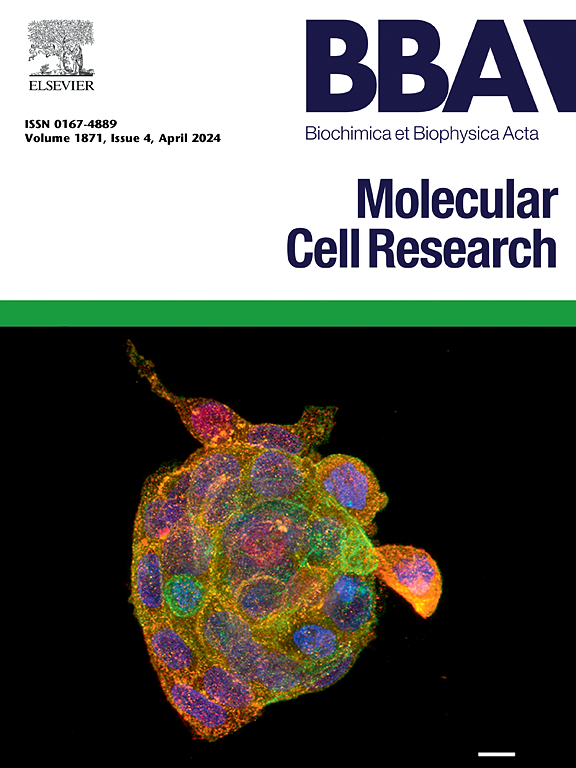内皮细胞上表达的角蛋白通过与血栓调节蛋白相互作用调节血管炎症和血管生成。
IF 4.6
2区 生物学
Q1 BIOCHEMISTRY & MOLECULAR BIOLOGY
Biochimica et biophysica acta. Molecular cell research
Pub Date : 2025-02-01
DOI:10.1016/j.bbamcr.2024.119891
引用次数: 0
摘要
血栓调节蛋白主要在血管内皮细胞上表达,并通过与多种配体相互作用调节内皮细胞功能。内皮细胞表面特定的血栓调节素受体或辅助因子活性尚不明确。本研究旨在确定血栓调节素对内皮细胞的相互作用伙伴。在这里,使用液相色谱-串联质谱仪,角蛋白被确定为候选蛋白。然后我们研究了内皮细胞中角蛋白和mRNA的表达。在小鼠主动脉和肺内皮中检测到Hornerin蛋白。人和小鼠内皮细胞均表达角蛋白mRNA和蛋白。此外,免疫沉淀分析表明血栓调节蛋白和角蛋白之间存在直接的蛋白相互作用。脂多糖增加小鼠血清角蛋白浓度,降低培养内皮细胞表面角蛋白水平,与血栓调节蛋白水平相同。以血栓调节蛋白为靶点的siRNA不仅能降低培养内皮细胞的血栓调节蛋白水平,还能降低角蛋白水平。以血栓调节素或角蛋白为靶点的siRNA会破坏小管的形成和白细胞与内皮细胞的粘附。我们的研究结果表明,在血栓调节蛋白存在的情况下,角蛋白位于血管内皮细胞上,表明内皮血栓调节蛋白和角蛋白可能相互作用,在血管炎症和血管生成等内皮细胞功能中发挥重要作用。本文章由计算机程序翻译,如有差异,请以英文原文为准。

Hornerin expressed on endothelial cells via interacting with thrombomodulin modulates vascular inflammation and angiogenesis
Thrombomodulin is predominantly expressed on vascular endothelial cells and modulates endothelial cell functions by interacting with multiple ligands. The specific thrombomodulin receptor or cofactor active on the endothelial cell surface remains elusive. This study aims to identify interacting partners of thrombomodulin on endothelial cells. Here, using a liquid chromatograph-tandem mass spectrometer, hornerin was identified as a candidate protein. We then investigated hornerin protein and mRNA expression in endothelial cells. Hornerin protein was detected in the mouse endothelium of the aorta and lung. Both human- and mouse-cultured endothelial cells expressed hornerin mRNA and protein. Moreover, immunoprecipitation analysis suggested the direct protein interaction between thrombomodulin and hornerin. Lipopolysaccharides administration increased serum hornerin concentrations in mice and reduced hornerin protein levels on the surface of cultured endothelial cells as same as thrombomodulin protein. Thrombomodulin-targeting siRNA decreased not only thrombomodulin protein levels but also hornerin protein levels in cultured endothelial cells. Thrombomodulin- or hornerin-targeting siRNA impaired tube formation and leukocyte adhesion to endothelial cells. Our findings reveal that hornerin is located on vascular endothelial cells in the presence of thrombomodulin and suggest that endothelial thrombomodulin and hornerin may interact, which may play an important role in endothelial cell functions such as vascular inflammation and angiogenesis.
求助全文
通过发布文献求助,成功后即可免费获取论文全文。
去求助
来源期刊
CiteScore
10.00
自引率
2.00%
发文量
151
审稿时长
44 days
期刊介绍:
BBA Molecular Cell Research focuses on understanding the mechanisms of cellular processes at the molecular level. These include aspects of cellular signaling, signal transduction, cell cycle, apoptosis, intracellular trafficking, secretory and endocytic pathways, biogenesis of cell organelles, cytoskeletal structures, cellular interactions, cell/tissue differentiation and cellular enzymology. Also included are studies at the interface between Cell Biology and Biophysics which apply for example novel imaging methods for characterizing cellular processes.

 求助内容:
求助内容: 应助结果提醒方式:
应助结果提醒方式:


